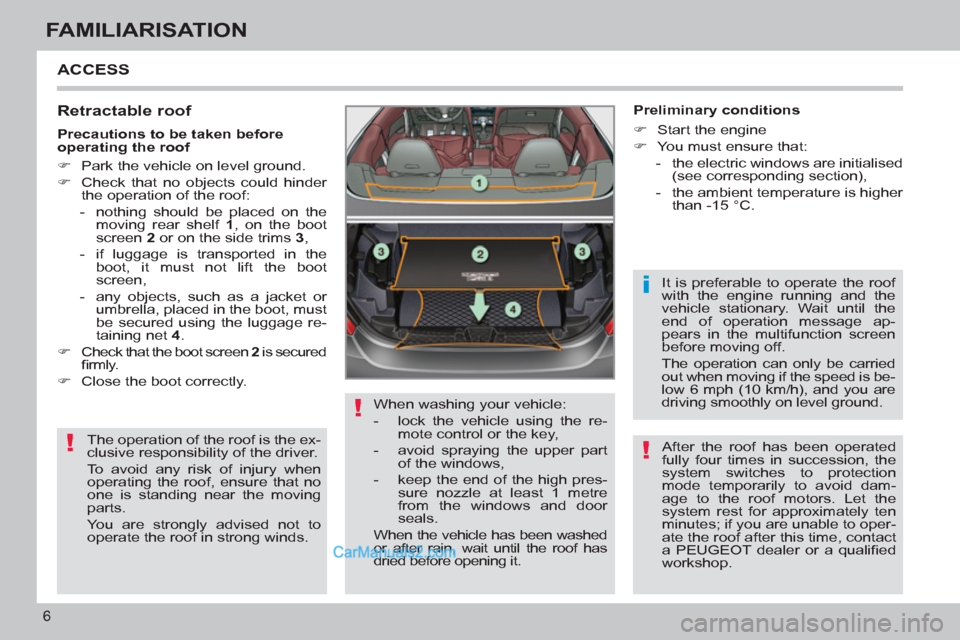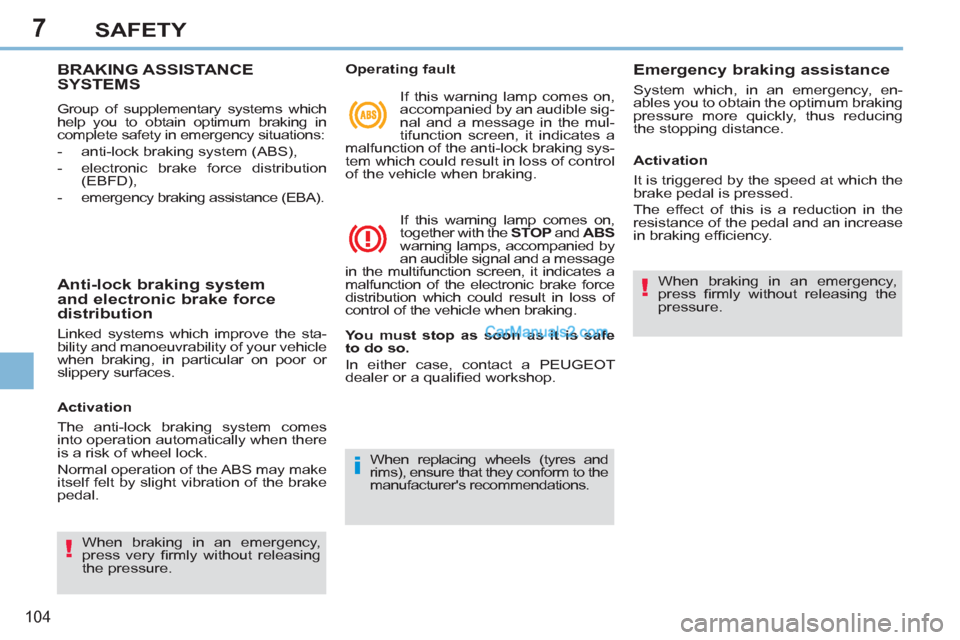2011 Peugeot 308 CC rims
[x] Cancel search: rimsPage 8 of 292

!
!
i
!
6
FAMILIARISATION
ACCESS
Retractable roof
The operation of the roof is the ex-
clusive responsibility of the driver.
To avoid any risk of injury when
operating the roof, ensure that no
one is standing near the moving
parts.
You are strongly advised not to
operate the roof in strong winds. When washing your vehicle:
- lock the vehicle using the re-
mote control or the key,
- avoid spraying the upper part
of the windows,
- keep the end of the high pres-
sure nozzle at least 1 metre
from the windows and door
seals.
When the vehicle has been washed
or after rain, wait until the roof has
dried before opening it. It is preferable to operate the roof
with the engine running and the
vehicle stationary. Wait until the
end of operation message ap-
pears in the multifunction screen
before moving off.
The operation can only be carried
out when moving if the speed is be-
low 6 mph (10 km/h), and you are
driving smoothly on level ground.
Preliminary conditions
�)
Start the engine
�)
You must ensure that:
- the electric windows are initialised
(see corresponding section),
- the ambient temperature is higher
than -15 °C.
Precautions to be taken before
operating the roof
�)
Park the vehicle on level ground.
�)
Check that no objects could hinder
the operation of the roof:
- nothing should be placed on the
moving rear shelf 1
, on the boot
screen 2
or on the side trims 3
,
- if luggage is transported in the
boot, it must not lift the boot
screen,
- any objects, such as a jacket or
umbrella, placed in the boot, must
be secured using the luggage re-
taining net 4
.
�)
Check that the boot screen 2
is secured
fi rmly.
�)
Close the boot correctly.
After the roof has been operated
fully four times in succession, the
system switches to protection
mode temporarily to avoid dam-
age to the roof motors. Let the
system rest for approximately ten
minutes; if you are unable to oper-
ate the roof after this time, contact
a PEUGEOT dealer or a qualifi ed
workshop.
Page 106 of 292

7
!
i
!
104
SAFETY
BRAKING ASSISTANCE
SYSTEMS
Group of supplementary systems which
help you to obtain optimum braking in
complete safety in emergency situations:
- anti-lock braking system (ABS),
- electronic brake force distribution
(EBFD),
- emergency braking assistance (EBA).
Anti-lock braking system
and electronic brake force
distribution
Linked systems which improve the sta-
bility and manoeuvrability of your vehicle
when braking, in particular on poor or
slippery surfaces.
When braking in an emergency,
press very fi rmly without releasing
the pressure.
When replacing wheels (tyres and
rims), ensure that they conform to the
manufacturer's recommendations.
Operating fault
If this warning lamp comes on,
accompanied by an audible sig-
nal and a message in the mul-
tifunction screen, it indicates a
malfunction of the anti-lock braking sys-
tem which could result in loss of control
of the vehicle when braking.
If this warning lamp comes on,
together with the STOP
and ABS
warning lamps, accompanied by
an audible signal and a message
in the multifunction screen, it indicates a
malfunction of the electronic brake force
distribution which could result in loss of
control of the vehicle when braking.
Emergency braking assistance
System which, in an emergency, en-
ables you to obtain the optimum braking
pressure more quickly, thus reducing
the stopping distance.
Activation
The anti-lock braking system comes
into operation automatically when there
is a risk of wheel lock.
Normal operation of the ABS may make
itself felt by slight vibration of the brake
pedal.
Activation
It is triggered by the speed at which the
brake pedal is pressed.
The effect of this is a reduction in the
resistance of the pedal and an increase
in braking effi ciency.
When braking in an emergency,
press fi rmly without releasing the
pressure.
You must stop as soon as it is safe
to do so.
In either case, contact a PEUGEOT
dealer or a qualifi ed workshop.
Page 107 of 292

7
!
105
SAFETY
The ESP/ASR systems offer ex-
ceptional safety in normal driving,
but this should not encourage the
driver to take extra risks or drive at
high speed.
The correct functioning of these
systems depends on observation
of the manufacturer's recommen-
dations on:
- wheels (tyres and rims),
- braking components,
- electronic components,
- repair and assembly procedures.
After an impact, have these sys-
tems checked by a PEUGEOT
dealer or a qualifi ed workshop.
Deactivation
In exceptional conditions (starting a ve-
hicle which is bogged down, stuck in
snow, on soft ground, ...), it may be ad-
visable to deactivate the ASR and ESP
systems, so that the wheels can move
freely and regain grip.
�)
Press the "ESP OFF"
button, located
in the middle of the dashboard.
If this warning lamp comes on in
the instrument panel and the indi-
cator lamp in the button come on,
this indicates that the ASR and
ESP systems are deactivated.
On vehicles fi tted with the 1.6 litre THP 200 hp
engine, this action also deactivates the auto-
matic operation of hazard warning lamps.
Reactivation
These systems are reactivated automati-
cally each time the ignition is switched
back on or from 30 mph (50 km/h) (except
in the case of the 1.6 litre THP 200 hp
petrol engine).
�)
Press the "ESP OFF"
button again
to reactivate them manually.
Operating fault
If this warning lamp comes on,
accompanied by an audible
signal and a message in the
screen, this indicates a mal-
function of these systems.
Have it checked by a PEUGEOT dealer
or a qualifi ed workshop.
TRAJECTORY CONTROL
SYSTEMS
Activation
These systems are activated automati-
cally each time the vehicle is started.
Anti-slip regulation (ASR) and
electronic stability programme
(ESP)
They come into operation in the event
of a grip or trajectory problem.
This is indicated by fl ashing of
this warning lamp in the instru-
ment panel.
The anti-slip regulation (also known as
Traction Control) optimises traction to
prevent skidding of the wheels, by acting
on the brakes of the driving wheels and
on the engine.
The electronic stability programme acts
on the brake of one or more wheels and
on the engine to keep the vehicle on the
trajectory required by the driver, within
the limits of the laws of physics. On vehicles fi tted with the 1.6 litre THP
200 hp engine, this action also reacti-
vates the automatic operation of hazard
warning lamps.